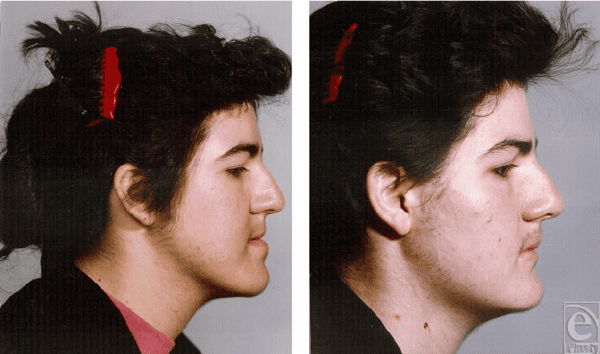
The Habsburg Jaw, a unique physical trait seen throughout generations of the Habsburg family, has been a topic of fascination for scientists and historians alike. This pronounced jawline is characterized by an extended and protruding lower jaw, often accompanied by an undershot or misaligned bite.
The Habsburg Jaw, the most famous case of mandibular prognathism, left a lasting impact on the Habsburg family, which once ruled over much of Europe for a staggering 700 years.
In order to secure its influence and legacy, the German-Austrian family relied on generations of intermarriage. Among the House of Habsburg, uncle-niece, first cousins, and other consanguineous unions were prevalent. What could go wrong?
In the end, this strategy would doom what was once at one point in time the most influential royal bloodline in the world. Today, the Habsburgs are all but forgotten from mainstream public consciousness, apart from one notable feature: the famous Habsburg Jaw.
This uniquely deformed jawline, so prevalent in the Habsburg family portraits, marked them out and became an unflattering symbol of their innbred legacy.
What is the Habsburg Jaw?

The Habsburg Jaw, clinically known as mandibular prognathism, is characterized by a prominent, protruding lower jaw and a receding or undersized upper jaw, leading to a distinctive facial profile. In severe cases, it may affect one’s ability to speak or eat.
Many Habsburgs, as seen in their portraits, also had a thick, lower lip and a nose that was larger than average.
The Habsburg Jaw was most prevalent in Charles II of Spain (1661-1700), the last king of the Spanish Hapsburg line. His distinct facial feature was a direct result of generations of inbreeding in the Habsburg family, an ironic testament to their attempt at preserving what they believed to be a perfect bloodline.
Painters of the time, such as Diego Velázquez and Frans Pourbus the Younger, masterfully captured these physical traits in the 16th and 17th centuries. Today, these paintings are often used as memes on the internet.
What causes the Habsburg Jaw?
A 2019 study published in the Annals of Human Biology has confirmed that facial deformities in the Habsburg bloodline, colloquially known as the “Habsburg jaw”, can be traced to inbreeding.
The most famous example of mandibular prognathism was Charles II of Spain. Born in 1661, he was the last king of the Spanish Hapsburgs line.
In many ways, Charles was the culmination of hundreds of years of inbreeding in a royal blood empire. The Habsburgs ironically thought of their bloodline as perfect. In reality, the last Habsburgs were anything but that.
Charles II died prematurely aged 39 but not before his foolish behavior plunged his kingdom into chaos, eventually leading to the War of Spanish Succession. This was the first world war of modern times with theatres of war in Spain, Italy, Germany, Holland, and at sea. It’s estimated the war resulted in 400,000 casualties.
According to one biography, King Charles had such a distinctive and overly pronounced Habsburg jaw that his upper and lower teeth could not touch each other, making chewing impossible. His tongue was disproportionally large, causing his speech to be barely understandable.
Unfortunately, his cognitive abilities were equally impaired. Carlos’ existence was mostly marked by an extended childhood that hastily segued into premature old age. The primary concern of his family was to ensure his survival, with his education being neglected to the point where he struggled with basic literacy. He was nursed until he was five or six years old and was not allowed to attempt walking until he was nearly an adult.
Even as a grown-up, he couldn’t walk properly as his legs lacked the strength to hold him upright, leading to numerous falls. He had the physique of a chronically unwell child. His sheltered upbringing, poor education, strict court protocol, reliance on his mother, and superstitions all combined to mold him into a mentally challenged and excessively sensitive king.
Facial deformities, as well as a history of mental illness, run deep in the Habsburg family line. Though long suspected, it wasn’t until recently that the distinct “Habsburg jaw” has been confirmed as the result of inbreeding.
The deformed House of Habsburg
Francisco Ceballos is a geneticist who for years has been studying genomic inbreeding in world populations. Ceballos and colleagues enlisted the help of ten maxillofacial surgeons who were asked to use their expertise and judge facial deformity in 66 portraits depicting 11 Habsburg family members.
Many of these portraits are curated by some of the world’s foremost art museums, including the Prado Museum in Madrid and the Kunsthistorisches Museum in Vienna. The study only employed paintings where it has been historically confirmed that the authors had personally seen the individual portrayed.

The experts scored each family member on their degree of mandibular prognathism and maxillary deficiency (a prominent lower lip and an overhanging nasal tip respectively). Meanwhile, the researchers calculated the inbreeding coefficient of the Habsburg kings and queens by examining genealogical databases, which included more than 6,000 individuals belonging to more than 20 generations.
“Our main objective of our research is to understand the genetic architecture of the human face. And for that, we use the Habsburg as true human genetic laboratories. The main question is if the “Habsburg face” is affected by the inbreeding they practiced,” Ceballos told ZME Science.
“The “Habsburg jaw” is not just a prognathism problem but the combination of two issues: mandibular prognathism (MP) and maxillary deficiency (MD). That is why it should be named “Habsburg face”. By studying the effect of inbreeding over those traits we can learn a lot about their genetic architecture: Is it ruled by a few genes with strong effects? Or by a plethora of genes with mild effects? Are these effects recessive or dominant?”

According to the results, Mary of Burgundy, who married into the family in 1477, showed the least degree of both traits.
The most pronounced prognathism was found in Philip IV, King of Spain and Portugal, who ruled from 1621 to 1640.
The greatest degree of maxillary deficiency was found in five family members: Maximilian I (regent from 1493), his daughter Margaret of Austria, his nephew Charles I of Spain, Charles’ great-grandson Philip IV and the last in the Habsburg line, Charles II.

The researchers analyzed the effects of inbreeding on the degree of mandibular prognathism and maxillary deficiency by employing statistical methods, finding that the two traits share a common genetic basis.
“The ‘Aha!’ moment was when we discovered that the MD is affected indeed by inbreeding, and that the Habsburg face is indeed related to their consanguinity. This is the first time that science backs up this statement,” Ceballos told me over e-mail.
The Habsburg Jaw and inbreeding
It is yet unclear, however, how facial deformity and inbreeding are connected. That’s not to say that there aren’t any possible explanations. Mating between relatives is known to increase the odds of offspring inheriting identical forms of a gene from both parents (genetic homozygosity). This can reduce an individual’s genetic fitness.
Charles V, for instance, was believed to suffer from at least two conditions caused by recessive mutations in different genes: pituitary hormone deficiency (which can result in infertility) and distal renal tubular acidosis, a cause of kidney failure.
“While our study is based on historical figures, inbreeding is still common in some geographical regions and among some religious and ethnic groups, so it’s important today to investigate the effects,” lead researcher Professor Roman Vilas from the University of Santiago de Compostela said in a statement.
“The Habsburg dynasty serves as a kind of human laboratory for researchers to do so, because the range of inbreeding is so high.”
In the future, the research team plans on investigating the genetic architecture of the human face more broadly by including other royal dynasties.
“We were able to answer many questions, like the heritability of these traits and other insights of their genetic architecture. Also we are using these dynasties (not just the Habsburgs) to get insights into the genetics of fertility, life expectancy, etc. We also calculated the inbreeding coefficient of every royal family of Europe until nowadays,” Ceballos said.
“It is possible to study the genetics of the human face: the mirror of the soul by using the information we have about our European royals. As we have shown in different papers, these royal dynasties are a magnificent genetic human laboratory, where science, history and art come together. We can learn a lot of modern genetics from them, even without having any single molecule of DNA,” he concluded.
Modern Examples of the Habsburg Jaw
While the Habsburg dynasty is the most famous historical example of prognathism, there other historical personalities that suffered from the same genetic problems. The Habsburg practice of marrying in the family was far from being a singular example. On the contrary, many ruling elites across the world, from Europe to China, employed the same practice to create bridges and unions between powerful families.
Some notable examples of prognathism outside the House of Habsburg include:
- Frederick, regent of Denmark-Norway
- Pedro II of Brazil
- Emperor Kōmei of Japan.
- Vlad III aka Vlad the Impaler

Mandibular prognathism still affects people today, though it’s generally less common and not as pronounced as in the Habsburg family.
Modern examples are rare, and when this condition appears, it’s often less severe and can be corrected with orthodontic treatment or surgery. Unlike in the past, the stigma around such genetic conditions has lessened, and medical advancements allow individuals with this trait to lead normal, healthy lives.
From the austere portraits in ancient European castles to the light-hearted memes on our digital screens, the Habsburg Jaw stands as a stark reminder of the profound influence of genetic inheritance.



